Soil Respiration in Planted and Naturally Regenerated Castanopis carelesii Forests during Three Years Post-Establishment
Abstract
:1. Introduction
2. Materials and Methods
2.1. Study Site
2.2. Experimental Design
2.3. Measurement of Soil Respiration, Temperature, and Moisture
2.4. Data Analysis
3. Results
3.1. Rainfall, Soil Moisture, and Temperature
3.2. Total, Heterotrophic, and Autotrophic Soil Respiration
3.3. Relationships between Soil Temperature, Moisture, and Rs and Its Components
4. Discussion
4.1. Temporal Patterns of Soil Respiration and Its Components among Different Forests
4.2. The Responses of Q10 to the Forest Regeneration Approach
4.3. General Discussion
5. Limitations and Conclusions
Author Contributions
Funding
Informed Consent Statement
Data Availability Statement
Acknowledgments
Conflicts of Interest
References
- Lewis, S.L. The Paris agreement has solved a troubling problem. Nature 2016, 532, 283. [Google Scholar] [CrossRef] [PubMed] [Green Version]
- IPCC. Summary for policymarkers. In An IPCC Special Report on the Impacts of Global Warming of 1.5 °C above Pre-Industrial Levels and Related Global Greenhouse Gas Emission Pathways, in the Context of Strengthening the Global Response to the Threat of Climate Change, Sustainable Development, and Efforts to Eradicate Poverty; Allen, M., Babiker, M., Chen, Y., Coninck, H.D., Connors, S., Diemen, R.V., Dube, O.P., Ebi, K.L., Engelbrecht, F., Ferrat, M., et al., Eds.; Global warming of 1.5 °C; International Panel for Climate Change: Geneva, Switzerland, 2018; p. 26. [Google Scholar]
- Guedes, B.S.; Olsson, B.A.; Egnell, G.; Sitoe, A.A.; Karltun, E. Plantations of Pinus and Eucalyptus replacing degraded mountain miombo woodlands in Mozambique significantly increase carbon sequestration. Glob. Ecol. Conserv. 2018, 14, e00401. [Google Scholar] [CrossRef]
- Shao, P.; Liang, C.; Lynch, L.; Xie, H.T.; Bao, X.L. Reforestation accelerates soil organic carbon accumulation: Evidence from microbial biomarkers. Soil Biol. Biochem. 2019, 131, 182–190. [Google Scholar] [CrossRef]
- Wang, X.G.; Zhou, M.H.; Li, T.; Ke, Y.; Zhu, B. Land use change effects on ecosystem carbon budget in the Sichuan Basin of Southwest China: Conversion of cropland to forest ecosystem. Sci. Total Environ. 2017, 609, 556–562. [Google Scholar] [CrossRef] [PubMed]
- Giasson, M.A.; Coursolle, C.; Margolis, H.A. Ecosystem-level CO2 fluxes from a boreal cutover in eastern Canada before and after scarification. Agric. For. Meteorol. 2006, 140, 23–40. [Google Scholar] [CrossRef]
- La Scala, N.; Lopes, A.; Spokas, K.; Bolonhezi, D.; Archer, D.W.; Reicosky, D.C. Short-term temporal changes of soil carbon losses after tillage described by a first-order decay model. Soil Tillage Res. 2008, 99, 108–118. [Google Scholar]
- Yang, Z.J.; Chen, G.S.; Liu, X.F.; Xiong, D.C.; Xu, C.; Mary, A.A.; Rebecca, L.M.; Si, S.H.; Yang, Y.S. Loss of soil organic carbon following natural forest conversion to Chinese fir plantation. Forest Ecol. Manag. 2019, 449, 117476. [Google Scholar] [CrossRef]
- Lewis, S.L.; Wheeler, C.E.; Mitchard, E.T.; Koch, A. Regenerate natural forests to store carbon. Nature 2019, 568, 25–28. [Google Scholar] [CrossRef]
- Davidson, E.A.; Richardson, A.D.; Savage, K.E.; Hollinger, D.Y. A distinct seasonal pattern of the ratio of soil respiration to total ecosystem respiration in a spruce-dominated forest. Glob. Chang. Biol. 2006, 12, 230–239. [Google Scholar] [CrossRef]
- IPCC. Summary for policymarkers. Climate Change: The Physical Science Basis. Contribution of Working Group I to the Fifth Assessment Report of the Intergovernmental Panel on Climate Change; Stocker, T.F., Qin, D., Plattner, G.K., Tignor, M., Allen, S.K., Boschung, J., Nauels, A., Xia, Y., Bex, V., Midgley, P.M., Eds.; Cambridge University Press: Cambridge, UK; New York, NY, USA, 2013; pp. 1–29. [Google Scholar]
- Jandl, R.; Lindner, M.; Vesterdal, L.; Bauwens, B.; Baritz, R.; Hagedorn, F.; Johnson, D.W.; Minkkinen, K.; Byrne, K.A. How strongly can forest management influence soil carbon sequestration? Geoderma 2007, 137, 253–268. [Google Scholar] [CrossRef]
- Zhou, L.; Zhou, X.; Shao, J.; Nie, Y.; He, Y.; Jiang, L.; Wu, Z.T.; Hosseini Bai, S. Interactive effects of global change factors on soil respiration and its components: A meta-analysis. Glob. Chang. Biol. 2016, 22, 3157–3169. [Google Scholar] [CrossRef] [PubMed]
- Bergner, B.; Johnstone, J.; Treseder, K.K. Experimental warming and burn severity alter soil CO2 flux and soil functional groups in a recently burned boreal forest. Glob. Chang. Biol. 2010, 10, 1996–2004. [Google Scholar] [CrossRef] [Green Version]
- Bernoux, M.; Cerri, C.C.; Cerri, C.E.P.; Neto, M.S.; Metay, A.; Perrin, A.S.; Scopel, E.; Razafimbelo, T.; Blavet, D.; Piccolo, M.C.; et al. Cropping systems, carbon sequestration and erosion in Brazil: A review. Agron. Sustain. Dev. 2006, 26, 1–8. [Google Scholar] [CrossRef] [Green Version]
- Mastrolonardo, G.; Rumpel, C.; Forte, C.; Doerr, S.H.; Certini, G. Abundance and composition of free and aggregate-occluded carbohydrates and lignin in two forest soils as affected by wildfires of different severity. Geoderma 2015, 245–246, 40–51. [Google Scholar] [CrossRef] [Green Version]
- Mataix Solera, J.; Cerdà, A.; Arcenegui, V.; Jordán, A.; Zavala, L.M. Fire effects on soil aggregation: A review. Earth Sci. Rev. 2011, 109, 44–60. [Google Scholar] [CrossRef]
- McLaughlin, J.W.; Gale, M.R.; Jurgensen, M.F.; Trettin, C.C. Soil organic matter and nitrogen cycling in response to harvesting, mechanical site preparation, and fertilization in a wetland with a mineral substrate. Forest Ecol. Manag. 2000, 129, 7–23. [Google Scholar] [CrossRef]
- Post, W.M.; Kwon, K.C. Soil carbon sequestration and land-use change: Processes and potential. Glob. Chang. Biol. 2010, 6, 317–327. [Google Scholar] [CrossRef] [Green Version]
- Dugan, P.C.; Durst, P.B.; Ganz, D.J.; Mckenzie, P.J. Advancing Assisted Natural Regeneration (ANR) in Asia and the Pacific; FAO Regional Office for Asia and the Pacific: Bangkok, Thailand, 2003. [Google Scholar]
- Li, Y.H. Methods of the natural regeneration of broad-leaved forests. J. Fujian Coll. For. 1985, 5, 21–26. (In Chinese) [Google Scholar]
- Shoo, L.P.; Catterall, C.P. Stimulating natural regeneration of tropical forest on degraded land: Approaches, outcomes, and information gaps. Restor. Ecol. 2013, 21, 670–677. [Google Scholar] [CrossRef]
- Yang, Y.S.; Wang, L.X.; Yang, Z.J.; Xu, C.; Xie, J.S.; Chen, G.S.; Lin, C.F.; Guo, J.F.; Liu, X.F.; Xiong, D.C.; et al. Large ecosystem service benefits of assisted natural regeneration. J. Geophys. Res.-Biogeo. 2018, 123, 676–687. [Google Scholar] [CrossRef]
- Hicks Pries, C.E.; Castanha, C.; Porras, R.C.; Torn, M.S. The whole-soil carbon flux in response to warming. Science 2017, 355, 1420–1423. [Google Scholar] [CrossRef] [PubMed] [Green Version]
- Wang, N.; Quesada, B.; Xia, L.; Butterbach-Bahl, K.; Goodale, C.L.; Kiese, R. Effects of climate warming on carbon fluxes in grasslands-A global meta-analysis. Glob. Chang. Biol. 2019, 25, 1839–1851. [Google Scholar] [CrossRef] [PubMed]
- Carvalhais, N.; Forkel, M.; Khomik, M.; Bellarby, J.; Jung, M.; Migliavacca, M.; Mu, M.Q.; Saatchi, S.; Santoro, M.; Thurner, M.; et al. Global covariation of carbon turnover times with climate in terrestrial ecosystems. Nature 2014, 514, 213–217. [Google Scholar] [CrossRef] [PubMed] [Green Version]
- Hardiman, B.S.; Gough, C.M.; Halperin, A.; Hofmeister, K.L.; Nave, L.E.; Bohrer, G.; Curtis, P.S. Maintaining high rates of carbon storage in old forests: A mechanism linking canopy structure to forest function. Forest Ecol. Manag. 2013, 298, 111–119. [Google Scholar] [CrossRef]
- Laganiere, J.; Angers, D.A.; Pare, D. Carbon accumulation in agricultural soils after afforestation: A meta-analysis. Glob. Chang. Biol. 2010, 16, 439–453. [Google Scholar] [CrossRef]
- Schlesinger, W.H.; Andrews, J.A. Soil respiration and the global carbon cycle. Biogeochemistry 2000, 48, 7–20. [Google Scholar] [CrossRef]
- Gordon, A.M.; Schlentner, R.E.; Cleve, K.V. Seasonal patterns of soil respiration and CO2 evolution following harvesting in the white spruce forests of interior Alaska. Can. J. For. Res. 1987, 17, 304–310. [Google Scholar] [CrossRef]
- Gupta, S.D.; DeLuca, T.H. Short-term changes in belowground C, N stocks in recently clear felled Sitka spruce plantations on podzolic soils of North Wales. Forest Ecol. Manag. 2012, 281, 48–58. [Google Scholar] [CrossRef]
- Hendrickson, O.Q.; Chatarpaul, L.; Burgess, D. Nutrient cycling following whole-tree and conventional harvest in northern mixed forest. Can. J. For. Res. 1989, 19, 725–735. [Google Scholar] [CrossRef]
- Londo, A.J.; Messina, M.G.; Schoenholtz, S.H. Forest harvesting effects on soil temperature, moisture, and respiration in a bottomland hardwood forest. Soil Sci. Soc. Am. J. 1999, 63, 637–644. [Google Scholar] [CrossRef]
- Lytle, D.E.; Cronan, C.S. Comparative soil CO2 evolution, litter decay, and root dynamics in clearcut and uncut spruce-fir forest. Forest Ecol. Manag. 1998, 103, 121–128. [Google Scholar] [CrossRef]
- Don, A.; Schumacher, J.; Freibauer, A. Impact of tropical land-use change on soil organic carbon stocks-a meta-analysis. Glob. Chang. Biol. 2011, 17, 1658–1670. [Google Scholar] [CrossRef] [Green Version]
- Van Noordwijk, M.; Cerri, C.; Woomer, P.L.; Nugroho, K.; Bernoux, M. Soil carbon dynamics in the humid tropical forest zone. Geoderma 1997, 79, 187–225. [Google Scholar] [CrossRef]
- Högberg, P.; Högberg, M.N.; Göttlicher, S.G.; Betson, N.R.; Keel, S.G.; Metcalfe, D.B.; Campbell, C.; Schindlbacher, A.; Hurry, V.; Lundmark, T.; et al. High temporal resolution tracing of photosynthate carbon from the tree canopy to forest soil microorganisms. New Phytol. 2007, 177, 220–228. [Google Scholar] [CrossRef]
- Liu, X.F.; Lin, T.C.; Yang, Z.J.; Vadeboncoeur, M.A.; Lin, C.F.; Xiong, D.C.; Lin, W.S.; Chen, G.S.; Xie, J.S.; Li, Y.Q.; et al. Increased litter in subtropical forests boosts soil respiration in natural forests but not plantations of Castanopsis carlesii. Plant Soil 2017, 418, 141–151. [Google Scholar] [CrossRef]
- McGuire, K.L.; Treseder, K.K. Microbial communities and their relevance for ecosystem models: Decomposition as a case study. Soil Biol. Biochem. 2010, 42, 529–535. [Google Scholar] [CrossRef] [Green Version]
- Tang, J.; Baldocchi, D.D.; Xu, L. Tree photosynthesis modulates soil respiration on a diurnal time scale. Glob. Chang. Biol. 2005, 11, 1298–1304. [Google Scholar] [CrossRef]
- Shono, K.; Cadaweng, E.A.; Durst, P.B. Application of assisted natural regeneration to restore degraded tropical forestlands. Restor. Ecol. 2007, 15, 620–626. [Google Scholar] [CrossRef]
- Yao, G.; Wang, H. Silviculture technique of natural second stand in Heilongjiang Province. J. Northeast. For. Univ. 1988, 16, 86–91. (In Chinese) [Google Scholar]
- Lloyd, J.; Taylor, J.A. On the temperature dependence of soil respiration. Funct. Ecol. 1994, 8, 315–323. [Google Scholar] [CrossRef]
- Li, Q.; Song, X.; Chang, S.X.; Peng, C.; Xiao, W.; Zhang, J.; Wang, W. Nitrogen depositions increase soil respiration and decrease temperature sensitivity in a Moso bamboo forest. Agric. For. Meteorol. 2019, 268, 48–54. [Google Scholar] [CrossRef]
- Striegl, R.G.; Wickland, K.P. Effects of a clear-cut harvest on soil respiration in a jack pine-lichen woodland. Can. J. For. Res. 1998, 28, 534–539. [Google Scholar] [CrossRef]
- Makita, N.; Pumpanen, J.; Köster, K.; Berninger, F. Changes in very fine root respiration and morphology with time since last fire in a boreal forest. Plant Soil 2016, 402, 303–316. [Google Scholar] [CrossRef]
- Xu, C.; Yang, Z.J.; Qian, W.; Chen, S.D.; Liu, X.F.; Lin, W.S.; Xiong, D.C.; Jiang, M.H.; Chang, C.T.; Huang, J.C.; et al. Runoff and soil erosion responses to rainfall and vegetation cover under various afforestation management regimes in subtropical montane forest. Land Degrad. Dev. 2019, 30, 1711–1724. [Google Scholar] [CrossRef]
- Guo, J.F.; Yang, Y.S.; Chen, G.S.; Xie, J.S.; Gao, R. Effects of clear-cutting and slash burning on soil respiration in Chinese fir and evergreen broadleaved forests in mid-subtropical China. Plant Soil 2010, 333, 249–261. [Google Scholar] [CrossRef]
- Hu, T.; Zhao, B.; Li, F. Effects of fire on soil respiration and its components in a Dahurian larch (Larix gmelinii) forest in northeast China: Implications for forest ecosystem carbon cycling. Geoderma 2021, 402, 115273. [Google Scholar] [CrossRef]
- Sheng, H.; Yang, Y.S.; Yang, Z.J.; Chen, G.S.; Xie, J.S.; Guo, J.F.; Zou, S.Q. The dynamic response of soil respiration to land-use changes in subtropical China. Glob. Chang. Biol. 2010, 16, 1107–1121. [Google Scholar] [CrossRef]
- Hu, S.C.; Xiong, D.C.; Huang, J.X.; Deng, F.; Chen, Y.Y.; Liu, X.F.; Chen, G.S. Fine root production in initial stage of Castanopsis carlesii under different regeneration modes in sanming, fujian province, China. Chin. J. Appl. Ecol. 2015, 25, 3259–3267. (In Chinese) [Google Scholar]
- Dias, A.; Ruijven, J.V.; Berendse, F. Plant species richness regulates soil respiration through changes in productivity. Oecologia 2010, 163, 805–813. [Google Scholar] [CrossRef] [Green Version]
- Drake, J.E.; Macdonald, C.A.; Tjoelker, M.G.; Crous, K.Y.; Gimeno, T.E. Short-term carbon cycling responses of a mature eucalypt woodland to gradual stepwise enrichment of atmospheric CO2 concentration. Glob. Chang. Biol. 2016, 22, 380–390. [Google Scholar] [CrossRef]
- Giardina, C.P.; Litton, C.M.; Crow, S.E. Warming-related increases in soil CO2 efflux are explained by increased below-ground carbon flux. Nat. Clim. Chang. 2014, 4, 822–827. [Google Scholar] [CrossRef] [Green Version]
- Macdonald, C.A.; Anderson, I.C.; Khachane, A.; Singh, B.P.; Barton, C.V.; Duursma, R.A.; Ellsworth, A.S.; Singh, B.K. Plant productivity is a key driver of soil respiration response to climate change in a nutrient-limited soil. Basic Appl. Ecol. 2021, 50, 155–168. [Google Scholar] [CrossRef]
- Schlesinger, W.H.; Lichter, J. Limited carbon storage in soil and litter of experimental forest plots under increased atmospheric CO2. Nature 2001, 411, 466–469. [Google Scholar] [CrossRef] [PubMed]
- Bond-Lamberty, B.; Wang, C.; Gower, S.T. A global relationship between the heterotrophic and autotrophic components of soil respiration? Glob. Chang. Biol. 2004, 10, 1756–1766. [Google Scholar] [CrossRef]
- Cahoon, S.; Sullivan, P.F.; Gamm, C.; Welker, J.M.; Eissenstat, D.; Post, E. Limited variation in proportional contributions of auto- and heterotrophic soil respiration, despite large differences in vegetation structure and function in the low arctic. Biogeochemistry 2016, 127, 339–351. [Google Scholar] [CrossRef]
- Xu, X.; Yang, B.; Wang, H.; Cao, Y.; Li, K.; Gao, S. Temperature sensitivity of soil heterotrophic respiration is altered by carbon substrate along the development of Quercus Mongolica forest in northeast China. Appl. Soil Ecol. 2019, 133, 52–61. [Google Scholar] [CrossRef]
- Barreiro, A.; Martin, A.; Carballas, T.; Diazravina, M. Long-term response of soil microbial communities to fire and fire-fighting chemicals. Biol. Fertil. Soils 2016, 52, 963–975. [Google Scholar] [CrossRef]
- Stirling, E.; Macdonald, L.M.; Smernik, R.J.; Cavagnaro, T.R. Post fire litters are richer in water soluble carbon and lead to increased microbial activity. Appl. Soil Ecol. 2019, 136, 101–105. [Google Scholar] [CrossRef]
- Mahecha, M.D.; Reichstein, M.; Carvalhais, N.; Lasslop, G.; Lange, H.; Seneviratne, S.I.; Richardson, A.D. Global convergence in the temperature sensitivity of respiration at ecosystem level. Science 2010, 329, 838–840. [Google Scholar] [CrossRef] [Green Version]
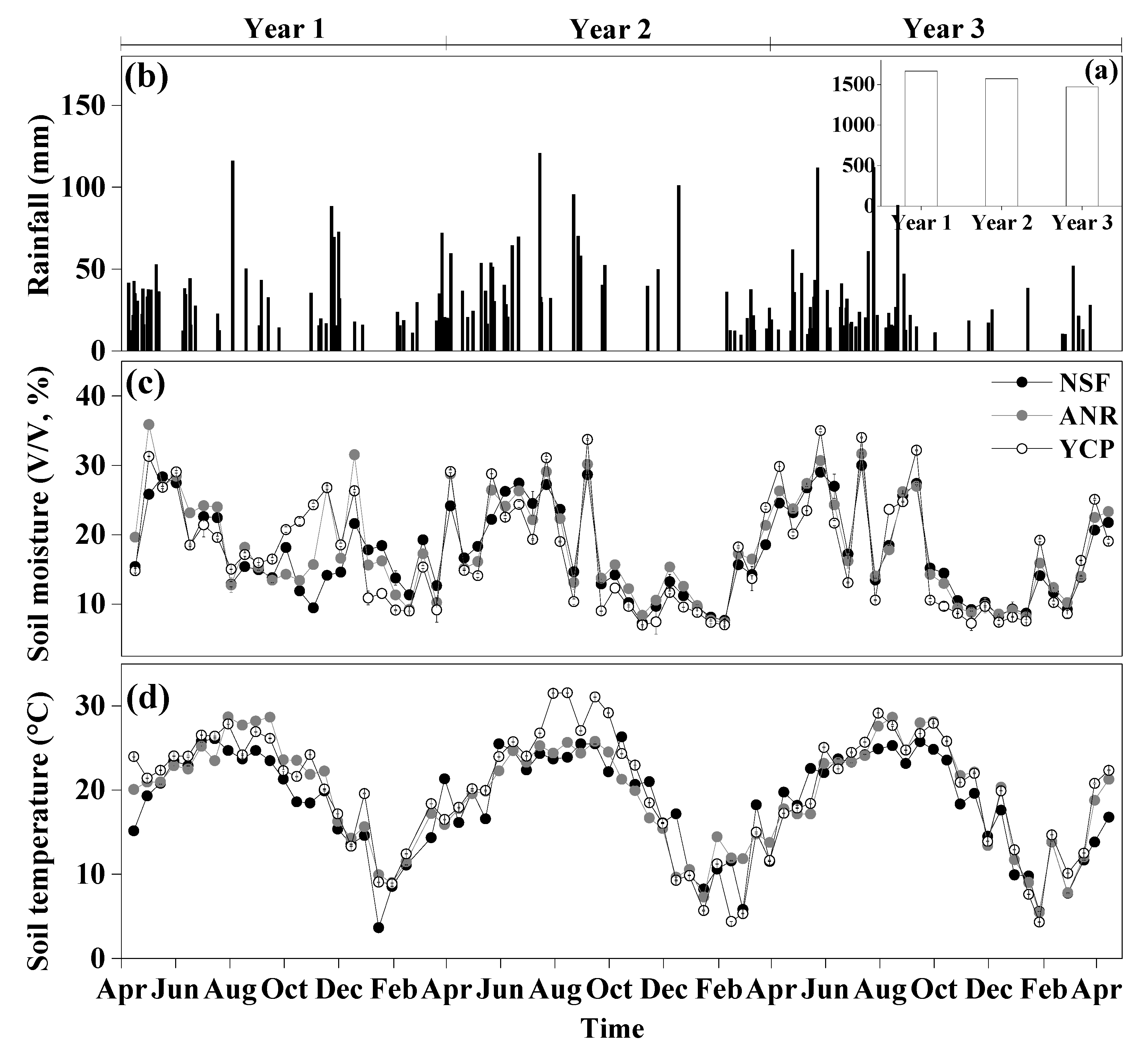
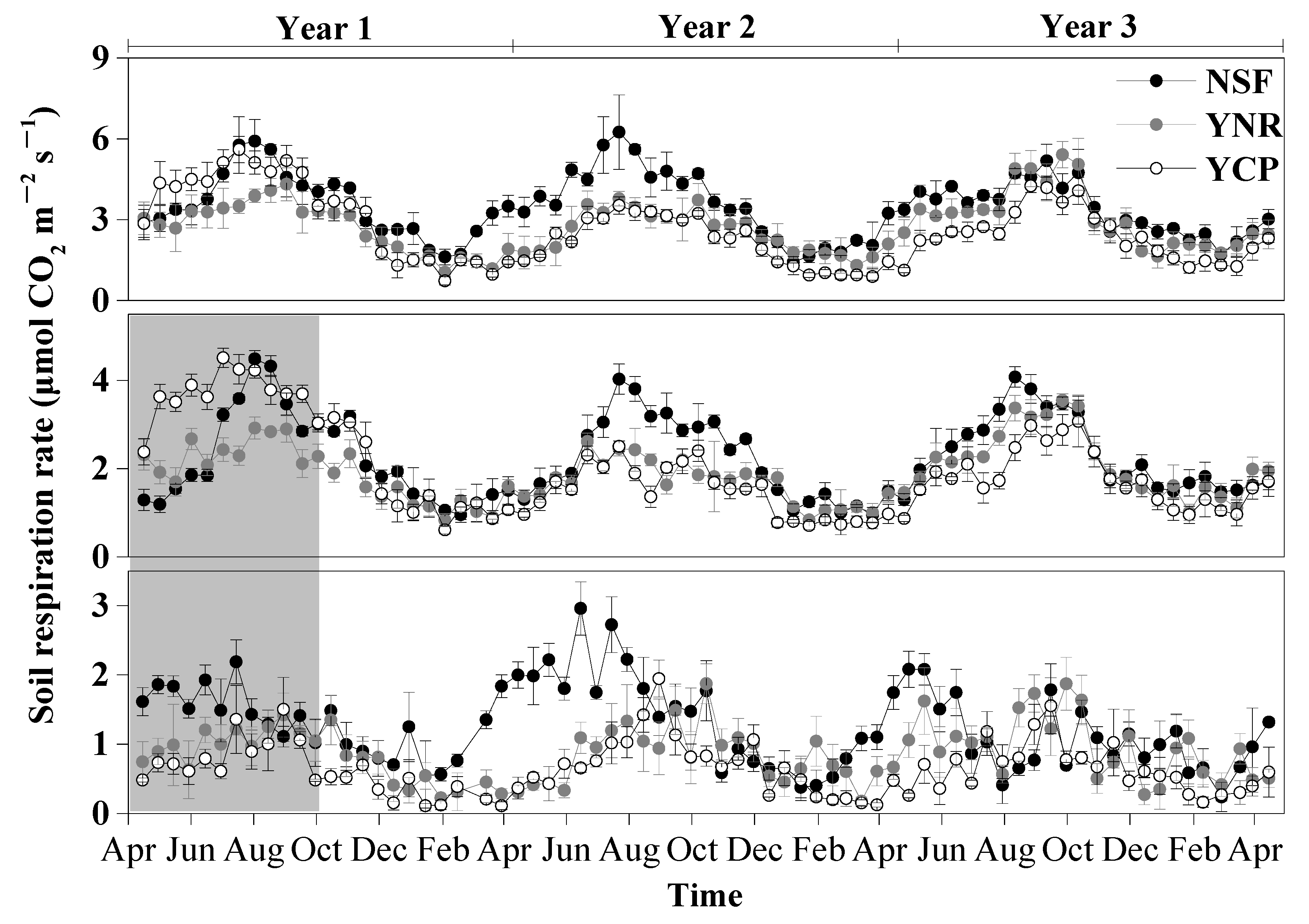
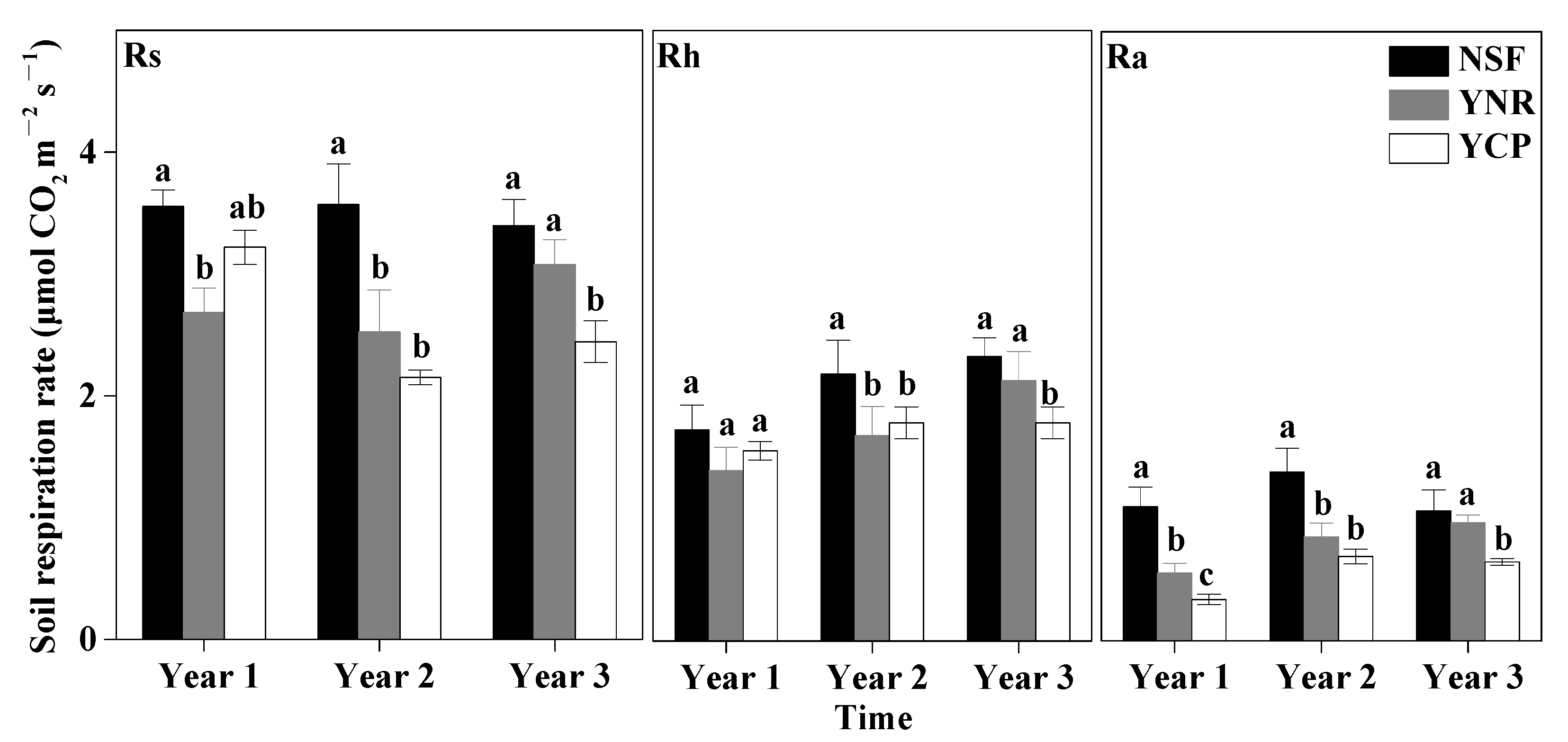
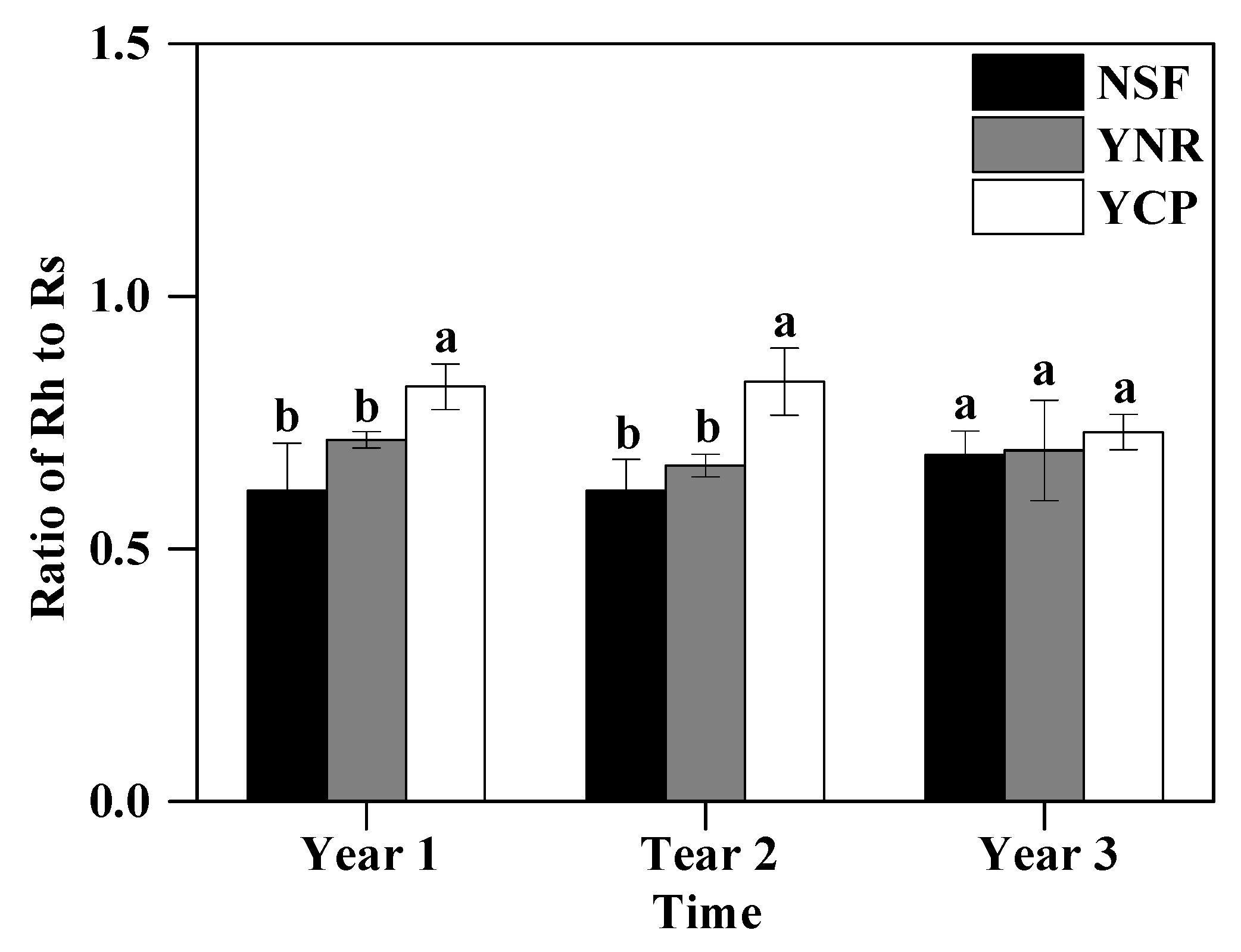
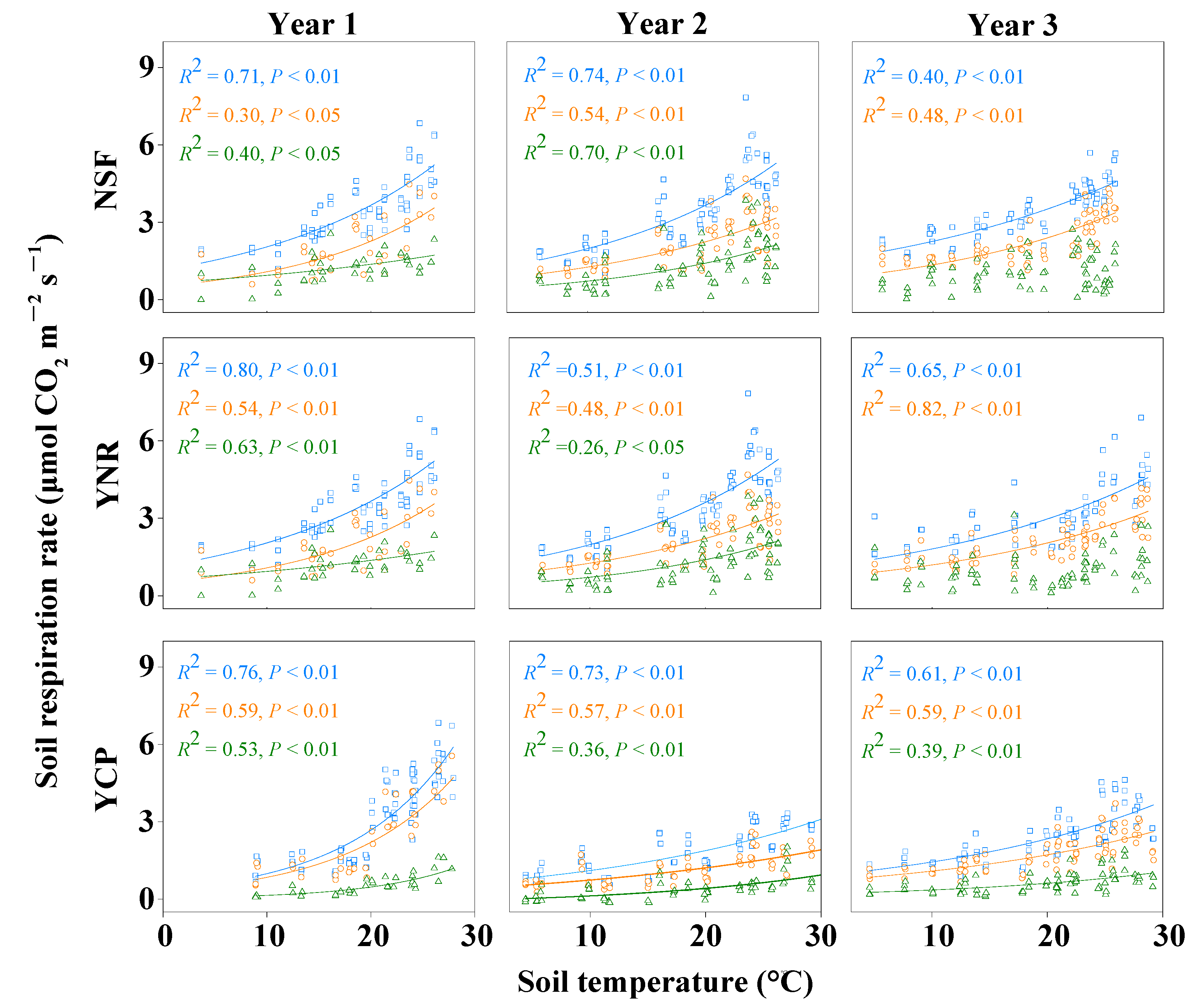
| Time | Factors | p | ||||
|---|---|---|---|---|---|---|
| Rs | Rh | Ra | Temperature | Moisture | ||
| Year 1 | Forest | <0.01 | <0.01 | <0.01 | <0.01 | <0.01 |
| Sampling time | <0.01 | <0.01 | <0.01 | <0.01 | <0.01 | |
| Forest × Sampling time | <0.01 | <0.01 | <0.01 | <0.01 | <0.01 | |
| Year 2 | Forest | <0.01 | <0.01 | <0.01 | 0.166 | <0.01 |
| Sampling time | <0.01 | <0.01 | <0.01 | <0.01 | <0.01 | |
| Forest × Sampling time | <0.01 | <0.01 | <0.01 | <0.01 | <0.01 | |
| Year 3 | Forest | <0.01 | <0.01 | <0.01 | <0.01 | <0.01 |
| Sampling time | <0.01 | <0.01 | <0.01 | <0.01 | <0.01 | |
| Forest × Sampling time | <0.01 | 0.011 | <0.01 | <0.01 | <0.01 | |
| Time | Forest Type | Q10 | ||
|---|---|---|---|---|
| Rs | Rh | Ra | ||
| Year 1 | NSF | 1.75b | 1.75b | 1.91b |
| YNR | 1.88b | 1.60b | 2.04b | |
| YCP | 2.76a | 2.10a | 3.00a | |
| Year 2 | NSF | 1.86a | 1.75a | 2.08a |
| YNR | 1.44b | 1.42b | 1.52b | |
| YCP | 1.60b | 1.50b | 1.90b | |
| Year 3 | NSF | 1.57a | 1.62a | 1.54a |
| YNR | 1.57a | 1.61a | 1.52a | |
| YCP | 1.61a | 1.58a | 1.70a | |
| Time | Forest Type | R2 | ||
|---|---|---|---|---|
| Rs | Rh | Ra | ||
| Year 1 | NSF | <0.01 | 0.14 | 0.04 |
| YNR | 0.04 | 0.11 | 0.01 | |
| YCP | 0.20 | 0.30 | 0.22 | |
| Year 2 | NSF | 0.41 ** | 0.14 | 0.62 ** |
| YNR | 0.12 | 0.15 | 0.03 | |
| YCP | 0.08 | 0.07 | 0.01 | |
| Year 3 | NSF | 0.37 ** | 0.11 | 0.34 * |
| YNR | 0.12 | 0.07 | 0.14 * | |
| YCP | 0.05 | 0.02 | 0.12 | |
Publisher’s Note: MDPI stays neutral with regard to jurisdictional claims in published maps and institutional affiliations. |
© 2022 by the authors. Licensee MDPI, Basel, Switzerland. This article is an open access article distributed under the terms and conditions of the Creative Commons Attribution (CC BY) license (https://creativecommons.org/licenses/by/4.0/).
Share and Cite
Wei, Z.; Lin, C.; Xu, C.; Xiong, D.; Liu, X.; Chen, S.; Lin, T.; Yang, Z.; Yang, Y. Soil Respiration in Planted and Naturally Regenerated Castanopis carelesii Forests during Three Years Post-Establishment. Forests 2022, 13, 931. https://doi.org/10.3390/f13060931
Wei Z, Lin C, Xu C, Xiong D, Liu X, Chen S, Lin T, Yang Z, Yang Y. Soil Respiration in Planted and Naturally Regenerated Castanopis carelesii Forests during Three Years Post-Establishment. Forests. 2022; 13(6):931. https://doi.org/10.3390/f13060931
Chicago/Turabian StyleWei, Zhihua, Chengfang Lin, Chao Xu, Decheng Xiong, Xiaofei Liu, Shidong Chen, Tengchiu Lin, Zhijie Yang, and Yusheng Yang. 2022. "Soil Respiration in Planted and Naturally Regenerated Castanopis carelesii Forests during Three Years Post-Establishment" Forests 13, no. 6: 931. https://doi.org/10.3390/f13060931
APA StyleWei, Z., Lin, C., Xu, C., Xiong, D., Liu, X., Chen, S., Lin, T., Yang, Z., & Yang, Y. (2022). Soil Respiration in Planted and Naturally Regenerated Castanopis carelesii Forests during Three Years Post-Establishment. Forests, 13(6), 931. https://doi.org/10.3390/f13060931






